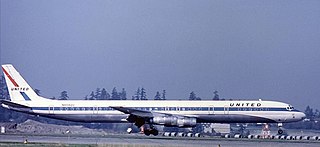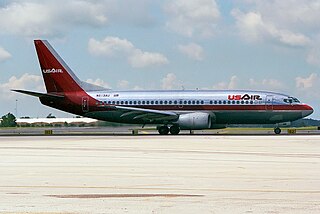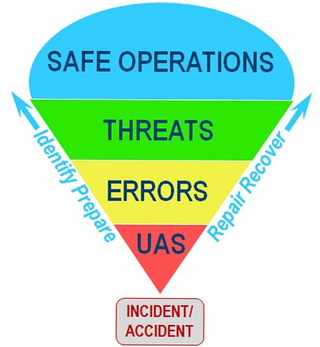
Delta Air Lines Flight 1141 was a scheduled domestic passenger flight between Dallas/Fort Worth, Texas and Salt Lake City, Utah. On August 31, 1988, the flight, using a Boeing 727-200 series aircraft, crashed during takeoff, resulting in 14 deaths and 76 injuries of the 108 on board.

United Airlines Flight 232 was a regularly scheduled United Airlines flight from Stapleton International Airport in Denver to O'Hare International Airport in Chicago, continuing to Philadelphia International Airport. On July 19, 1989, the DC-10 serving the flight crash-landed at Sioux Gateway Airport in Sioux City, Iowa, after suffering a catastrophic failure of its tail-mounted engine due to an unnoticed manufacturing defect in the engine's fan disk, which resulted in the loss of many flight controls. Of the 296 passengers and crew on board, 112 died during the accident, while 184 people survived. 13 of the passengers were uninjured. It was the deadliest single-aircraft accident in the history of United Airlines.

Aviation safety is the study and practice of managing risks in aviation. This includes preventing aviation accidents and incidents through research, educating air travel personnel, passengers and the general public, as well as the design of aircraft and aviation infrastructure. The aviation industry is subject to significant regulation and oversight.

Pilot error generally refers to an accident in which an action or decision made by the pilot was the cause or a contributing factor that led to the accident, but also includes the pilot's failure to make a correct decision or take proper action. Errors are intentional actions that fail to achieve their intended outcomes. The Chicago Convention defines the term "accident" as "an occurrence associated with the operation of an aircraft [...] in which [...] a person is fatally or seriously injured [...] except when the injuries are [...] inflicted by other persons." Hence the definition of "pilot error" does not include deliberate crashing.

United Airlines Flight 173 was a scheduled flight from John F. Kennedy International Airport in New York City to Portland International Airport in Portland, Oregon, with a scheduled stop in Denver, Colorado. On December 28, 1978, the aircraft flying this route ran out of fuel while troubleshooting a landing gear problem and crashed in a suburban Portland neighborhood near NE 157th Avenue and East Burnside Street, killing 10 people on board.

TWA Flight 843 was a scheduled Trans World Airlines passenger flight that crashed after an aborted takeoff from John F. Kennedy International Airport to San Francisco International Airport (California) in July 1992. Despite an intense fire after the crash, the crew was able to evacuate all 280 passengers from the aircraft. There was no loss of life, although the aircraft was destroyed by the fire.

Airmanship is skill and knowledge applied to aerial navigation, similar to seamanship in maritime navigation. Airmanship covers a broad range of desirable behaviors and abilities in an aviator. It is not simply a measure of skill or technique, but also a measure of a pilot’s awareness of the aircraft, the environment in which it operates, and of their own capabilities.

A runway incursion is an aviation incident involving improper positioning of vehicles or people on any airport runway or its protected area. When an incursion involves an active runway being used by arriving or departing aircraft, the potential for a collision hazard or Instrument Landing System (ILS) interference can exist. At present, various runway safety technologies and processes are commonly employed to reduce the risk and potential consequences of such an event.
Maintenance resource management (MRM) training is an aircraft maintenance variant on crew resource management (CRM). Although the term MRM was used for several years following CRM's introduction, the first governmental guidance for standardized MRM training and its team-based safety approach, appeared when the FAA (U.S.) issued Advisory Circular 120-72, Maintenance Resource Management Training in September, 2000.
Single-pilot resource management (SRM) is defined as the art and science of managing all the resources available to a single-pilot to ensure that the successful outcome of the flight is never in doubt. SRM includes the concepts of Aeronautical Decision Making (ADM), Risk Management (RM), Task Management (TM), Automation Management (AM), Controlled Flight Into Terrain (CFIT) Awareness, and Situational Awareness (SA). SRM training helps the pilot maintain situational awareness by managing the automation and associated aircraft control and navigation tasks. This enables the pilot to accurately assess and manage risk and make accurate and timely decisions.

USAir Flight 427 was a scheduled flight from Chicago's O'Hare International Airport to Palm Beach International Airport, Florida, with a stopover at Pittsburgh International Airport. On Thursday, September 8, 1994, the Boeing 737 flying this route crashed in Hopewell Township, Pennsylvania while approaching Runway 28R at Pittsburgh, which was USAir's largest hub at the time.
Maritime resource management (MRM) or bridge resource management (BRM) is a set of human factors and soft skills training aimed at the maritime industry. The MRM training programme was launched in 1993 – at that time under the name bridge resource management – and aims at preventing accidents at sea caused by human error.

Northwest Airlines Flight 85 was a scheduled international passenger flight from Detroit Metropolitan Wayne County Airport in the United States to Narita International Airport in Japan. On October 9, 2002, while over the Bering Sea, the Boeing 747-400 experienced a lower rudder hardover event, which occurs when an aircraft's rudder deflects to its travel limit without crew input. The 747's hardover gave full left lower rudder, requiring the pilots to use full right upper rudder and right aileron to maintain attitude and course.

In aviation safety, threat and error management (TEM) is an overarching safety management approach that assumes that pilots will naturally make mistakes and encounter risky situations during flight operations. Rather than try to avoid these threats and errors, its primary focus is on teaching pilots to manage these issues so they do not impair safety. Its goal is to maintain safety margins by training pilots and flight crews to detect and respond to events that are likely to cause damage (threats) as well as mistakes that are most likely to be made (errors) during flight operations.

Culture can affect aviation safety through its effect on how the flight crew deals with difficult situations; cultures with lower power distances and higher levels of individuality can result in better aviation safety outcomes. In higher power cultures subordinates are less likely to question their superiors. The crash of Korean Air Flight 801 in 1997 was attributed to the pilot's decision to land despite the junior officer's disagreement, while the crash of Avianca Flight 052 was caused by the failure to communicate critical low-fuel data between pilots and controllers, and by the failure of the controllers to ask the pilots if they were declaring an emergency and assist the pilots in landing the aircraft. The crashes have been blamed on aspects of the national cultures of the crews.

Pan Am Flight 799 was an international cargo flight from Los Angeles International Airport to Cam Ranh Airport in South Vietnam that crashed on December 26, 1968, near Anchorage, Alaska. The aircraft involved was a Boeing 707-321C aircraft operated by Pan American World Airways. All three crew members died in the crash.

Atlas Air Flight 3591 was a scheduled domestic cargo flight under the Amazon Air banner between Miami International Airport and George Bush Intercontinental Airport in Houston. On February 23, 2019, the Boeing 767-375ER(BCF) used for this flight crashed into Trinity Bay during approach into Houston, killing the two crew members and a single passenger on board. The accident occurred near Anahuac, Texas, east of Houston, shortly before 12:45 CST (18:45 UTC). This was the first fatal crash of a Boeing 767 freighter.

Transair Flight 810 was a Boeing 737-200 converted freighter aircraft, owned and operated by Rhoades Aviation under the Transair trade name, on a short cargo flight en route from Honolulu International Airport to Kahului Airport on the neighboring Hawaiian island of Maui. Immediately after an early morning takeoff on July 2, 2021, one of its two Pratt & Whitney JT8D turbofan engines faltered, and the first officer, who was flying the aircraft, reduced power to both. The two pilots—who were the only aircraft occupants—began executing the Engine Failure or Shutdown checklist, but became preoccupied with talking to air traffic control (ATC) and performing other flying tasks, and never reached the section of the checklist where the failing engine was to be positively identified and shut down. The captain assumed control but misidentified the failing engine, increased power to that engine, and did not increase power to the other, properly functioning engine. Convinced that neither engine was working properly and unable to maintain altitude with one engine faltering and the other idling, the pilots ditched off the coast of Oahu about 11 minutes into the flight.

Tower Air Flight 41 was a scheduled domestic passenger flight from John F. Kennedy International Airport (JFK) in New York City, to Miami International Airport (MIA) in Florida. On December 20, 1995, the Boeing 747-100 operating the flight veered off the runway during takeoff from JFK. All 468 people on board survived, but 25 people were injured. The aircraft was damaged beyond repair and written off, making the accident the 25th hull loss of a Boeing 747. The National Transportation Safety Board (NTSB) concluded that the captain had failed to reject the takeoff in a timely manner.
An in-flight breakup is a catastrophic failure of an aircraft structure that causes it to break apart in mid-air. This can result in the death of all occupants, and/or the destruction of the aircraft. In-flight breakups are rare but devastating events that could be caused by a variety of factors.















